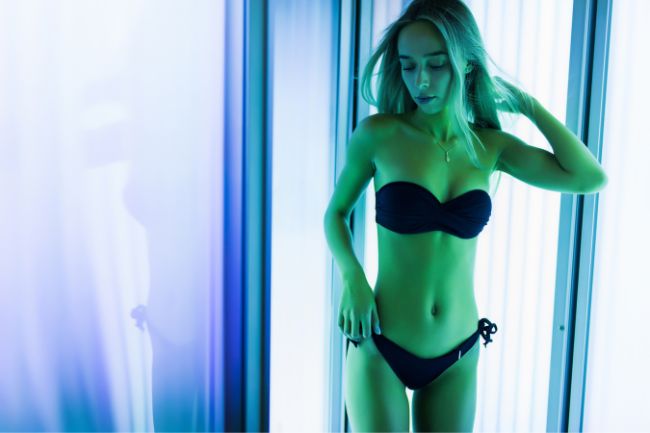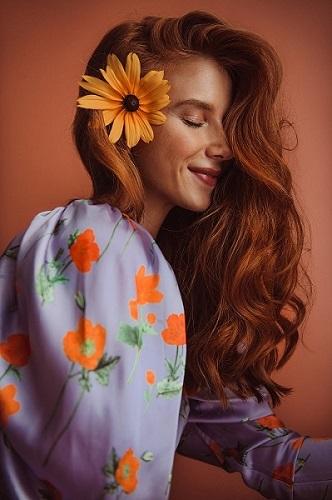Comparing tanning beds and sun exposure, both have their risks and potential harms. However, excessive and unprotected exposure to either can increase the risk of skin cancer, premature aging, and other skin damage, making it important to practice safe sun habits and moderate tanning bed use.
How does a tanning bed work?

Before we talk about the potential dangers associated with indoor tanning, it’s important to first understand what the process entails, as you may not have experienced it before. Unlike self-tanners or spray tans, a tanning bed uses processes which trigger your body to react in the same way as it would to the Sun, so your skin is left with a ‘natural’ tan.
When you use a tanning bed, your skin is exposed to artificial UV rays. There are three types of UV rays, but a tanning bed only emits UVA and UVB in order to bronze your skin. This is the same way you develop a suntan as a result of exposure to natural sunlight.
As your skin is exposed to the UV rays, primarily UVA rays penetrate your skin to reach small structures beneath the surface, known as melanocytes. These structures produce melanin, the pigment in your skin which determines its tone.
When they UV rays reach your melanocytes, they trigger the production of melanin, just as UV rays from the Sun do, and this results in a tan developing.
Are tanning beds dangerous?
The question of safety is a common one when it comes to talking about tanning beds, and this tanning method has a reputation for being potentially harmful for you and your skin. But what are the facts behind this?
Firstly, it’s important to understand that all UV exposure carries risks if it’s not paired with plenty of sunscreen (with a suitable protection factor). This means that even just leaving your house on a sunny day to go for a walk is risky when concerning your skin, so you should always ensure that you’re suitably protected.
Of course, as tanning beds do involve UV rays, they automatically carry a certain risk, which makes them a harmful procedure if you don’t use a protective lotion. However, they can still be dangerous (even with protective lotions), as intense UV exposure as you receive from a tanning bed can become a problem over time.
Also read: Should I Wear Sunscreen Every Day? (Advantages and Disadvantages)
Is a tanning bed worse than the Sun?
So, we’ve established that the Sun alone can carry risks for the skin, such as melanoma (the deadliest form of skin cancer), and so can a tanning bed. But is a tanning bed any more dangerous than the Sun?
While it seems like the perfect way to top up your colour throughout the year, the ugly truth behind tanning beds is that they are, generally, more dangerous than the Sun. It’s also worth noting that the dangers of UV radiation go further than just your skin, too.
The first issue with tanning beds is their high concentration of UVA. Generally, most tanning beds have a significantly high proportion of UVA rays, as these focus on giving your skin a tan, rather than burning as you would due to UVB exposure. In previous years, it was believed that UVA rays were the ‘safer’ of the two types of UV, however studies have proven that UVA rays do, in fact, have a stronger correlation with melanoma than UVB rays.
| Aspect | Tanning Bed UV Exposure | Sunlight UV Exposure |
|---|---|---|
| UV Intensity | Varies, but can be controlled with session duration | Varies depending on factors such as time of day and location |
| UVA and UVB Radiation | Both UVA and UVB radiation emitted | Both UVA and UVB radiation present |
| Vitamin D Production | Stimulates vitamin D production, but may require longer exposure | Stimulates vitamin D production in the skin |
| Controlled Environment | Indoor tanning beds provide a controlled environment | Outdoor sunlight exposure is less controlled |
| Sunburn Risk | Lower risk of sunburn due to controlled exposure | Higher risk of sunburn due to uncontrolled exposure |
| Skin Cancer Risk | Increased risk of skin cancer with excessive and unprotected exposure | Increased risk of skin cancer due to prolonged and unprotected exposure |
| Ageing and Wrinkles | May contribute to premature ageing and wrinkles | Prolonged sun exposure can accelerate ageing |
This means that, as a result of regular visits to your tanning salon, you increase the chances of developing melanoma significantly.

In addition to this, the intense exposure to UVA can have detrimental effects for your eyes, so your tanning salon should take appropriate precautions to prevent this. The salon should insist on you wearing goggles in order to protect your eyes and, if they don’t, you may wish to select another salon as this is a safety risk.
Of course, another risk associated with UV exposure is signs of premature aging in the skin, such as age spots, wrinkles, and fine lines. They are all caused by exposure to UVA rays and the intensity of a tanning bed session only speeds up the development of these signs. For anyone wishing to keep their youthful skin as long as possible, tanning beds may be a problem.
Finally, another point worth mentioning is vitamin D production, as there is a common misconception that using a tanning bed is good for you as it promotes vitamin D production. While this is true in the case of the Sun, tanning beds don’t actually promote vitamin D production as this is caused by exposure to UVB rays which convert a protein in the skin into vitamin D. However, as tanning beds contain little UVB, you won’t see this benefit as you will by spending time in natural sunlight.
Final thoughts
To conclude, it’s clear to see that tanning beds are worse than the Sun, and they carry many risks for your health, even if you do everything you can to make the process safer. If you want to remain truly safe and take good care of your skin, invest in sunless tanning methods instead, and use plenty of sunscreen when you’re outside.

